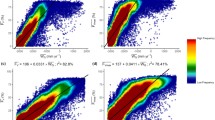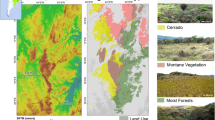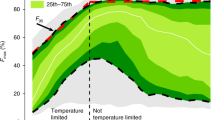Abstract
Direct observations as well as Normalized Difference Vegetation Index (NDVI) data from satellites have shown earlier leaf appearance in the northern hemisphere, which is believed to result from climate warming. The advance of leaf out to earlier times in the year could be limited or even reversed, however, as temperate and boreal trees require a certain amount of chilling in winter for rapid leaf out in spring. If this chilling requirement is not fulfilled, an increasing amount of warming is required. Implications of these chilling requirements at the biome level are not clear. One approach to estimate their importance is to generalize the exponential relationships between chilling and warming established for single species. Previous work using NDVI data suggests that this is indeed feasible but much has been limited to specific biomes or a very few years of data for the modelling. We find chilling requirements for northern temperate and boreal biomes by fitting various phenology models to green-up dates determined from NDVI using various methods and 12 years of data. The models predict that in northern middle and high latitudes the advance of green-up will be limited to a total of 4 to 5 days on average (but up to 15 days regionally) over the time period 2000–2060 as estimated using two contrasting climate simulations. This results from the exponentially increasing warming requirements for leaf out when winter chilling falls below a threshold as shown by a comparison with models that consider only spring warming. The model evaluation suggests an element of regional adaptation of the warming required for leaf out in large biomes.
Similar content being viewed by others
References
Allen DM (1974) The relationship between variable selection and data augmentation and a method for prediction. Technometrics 16:125–127
Armstrong L, Brodzik MJ (2002) Northern hemisphere EASE-grid weekly snow cover and sea ice extent version 2. National Snow and Ice Data Center, Boulder
Behrenfeld MJ, Randerson JT, McClain CR, Feldman GC, Los SO, Tucker CJ, Falkowski PG, Field CB, Frouin R, Esaias WE, Kolber DD, Pollack NH (2001) Biospheric primary production during an ENSO transition. Science 291:2594
Botta A, Viovy N, Ciais P, Friedlingstein P, Monfray P (2000) A global prognostic scheme of leaf onset using satellite data. Glob Chang Biol 6:709–725
Cannell MGR, Smith RI (1986) Climatic warming, spring budburst and frost damage to trees. J Appl Ecol 23:177–191
Chuine IP, Cour P (1999) Climatic determinants of budburst seasonality in four temperate zone tree species. New Phytol 143:339–349
Chuine IP, Cour P, Rousseau DD (1998) Fitting models predicting dates of flowering of temperate-zone trees using simulated annealing. Plant Cell Environ 21:455–466
Chuine IP, Cour P, Rousseau DD (1999) Selecting models to predict the timing of flowering of temperate trees: implication for tree phenology modelling. Plant Cell Environ 22:1–13
Delbart NJ, Kergoat L, Le Toan T, Lhermitte J, Picard G (2005) Determination of phenological dates in boreal regions using the normalized difference water index. Remote Sens Environ 97(1):26–38
Dye DG, Tucker CJ (2003) Seasonality and trends of snow-cover, vegetation index, and temperature in northern Eurasia. Geophys Res Lett 30:58-51–58-54
Fitzjarrald DR, Acevedo OC, Moore KE (2001) Climatic consequences of leaf presence in the eastern United States. J Climate 14:598–614
Freedman JM, Fitzjarrald DR, Moore KE, Sakai RK (2001) Boundary layer clouds and vegetation–atmosphere feedbacks. J Climate 14:180–197
Hall FG, Collatz G, Los S, Brown de Colstoun E, Landis D (eds) (2005) ISLSCP Initiative II. NASA. DVD/CD-ROM. NASA
Häkkinen R (1999) Statistical evaluation of bud development theories: application to bud burst of betula pendula leaves. Tree Physiol 19:613–618
Hanninen H (1990) Modelling bud dormancy release in trees from cool and temperate regions. Acta For Fenn 213:1–47
Hansen MC, DeFries RS, Townshend JRG, Sohlberg R (2000) Global land cover classification at 1 km spatial resolution using a classification tree approach. Int J Remote Sens 21:1331–1364
Heide OM (1993) Dormancy release in beech buds (Fagus sylvatica) requires both chilling and long days. Physiol Plant 187–191
Holben BN (1986) Characteristics of maximum-value composite images from temporal AVHRR data. Int J Remote Sens 7:1417–1434
Hunter AF, Lechowicz MJ (1992) Predicting the timing of budburst in temperate trees. J Appl Ecol 29:597–604
Hüttich C, Herold M, Schmullius C, Egorov V, Bartalev SA (2006) SPOT-VGT NDVI and NDWI trends 1998–2005 as indicators of recent land cover change processes in northern Eurasia. In: 2nd workshop of the EARSeL SIG on land use and land cover, Bonn, pp 336–344
IPCC (2000) Special report on emissions scenarios. Cambridge University Press, Cambridge
James ME, Kalluri SNV (1994) The pathfinder AVHRR land data set—an improved coarse resolution data set for terrestrial monitoring. Int J Remote Sens 15:3347–3363
Kaduk J, Heimann M (1996) A prognostic phenology scheme for global terrestrial carbon cycle models. Clim Res 6:1–19
Kang S, Running SW, Lim J-H, Zhao M, Parkb C-R, Loehman R (2003) A regional phenology model for detecting onset of greenness in temperate mixed forests, Korea: an application of MODIS leaf area index. Remote Sens Environ 86:232–242
Keeling CD, Chin JFS, Whorf TP (1996) Increased activity of northern vegetation inferred from atmospheric CO2 measurements. Nature 382:146–149
Kramer K (1994) Selecting a model to predict the onset of growth of Fagus sylvatica. J Appl Ecol 31:172–181
Kramer K (1995) Phenotypic plasticity of the phenology of seven European tree species, in relation to climatic warming. Plant Cell Environ 18:93–104
Kramer K (1996) Phenology and growth of European trees in relation to climate change. Landbouw Universiteit Wageningen
Lawrence DM, Slingo JM (2004) An annual cycle of vegetation in a GCM. Part II: global impacts on climate and hydrology. Clim Dyn 22:107–122
Linsser C (1867) Die periodschen Erscheinungen des Pflanzen-Lebens in ihrem Verhältniss zu den Wärme-Erscheinungen. Mem Acad Imp St Petersbourg (7)
Los SO (1998) Estimation of the ratio of sensor degradation between NOAA-AVHRR channels 1 and 2 from monthly NDVI composites. IEEE Trans Geosci Remote Sens 36:206–213
Los SO, Collatz GJ, Sellers PJ, Malmström CM, Pollack NH, DeFries RF, Bounoua L, Parris MT, Tucker CJ, Dazlich DA (2000) A global 9-year biophysical landsurface data set from NOAA AVHRR data. J Hydrometeorol 183–199
Los SO, North PRJ, Grey WMF, Barnsley MJ (2005) A method to convert AVHRR normalized difference vegetation index time series to a standard viewing and illumination geometry. Remote Sens Environ 99:400–411
Marell A, Hofgaard A, Danell K (2006) Nutrient dynamics of reindeer forage species along snowmelt gradients at different ecological scales. Basic Appl Ecol 7:13–30
Menzel A (2000) Trends in phenological phases in Europe between 1951 and 1996. Int J Biometeorol 44:76–81
Menzel A, Fabian P (1999) Growing season extended in Europe. Nature 397:659
Moulin S, Kergoat L, Viovy N, Dedieu G (1997) Global-scale assessment of vegetation phenology using NOAA/AVHRR satellite measurements. J Climate 10:1154–1170
Murray MB, Cannell MGR, Smith RI (1989) Date of budburst of fifteen tree species in Britain following climate warming. J Appl Ecol 26:693–700
Myking T (1997) Dormancy, budburst and impacts of climatic warming in coastal-inland and altitudinal Betula pendula and B. pubescens ecotypes. Progr Biometeorol 12:51–66
Myneni RB, Keeling CD, Tucker CJ, Asrar G, Nemani RR (1997) Increased plant growth in the northern high latitudes from 1981 to 1991. Nature 386:698–702
netlib.org (1977) Varpro: nonlinear least squares by variable projection
Ng AY (1997) Preventing “overfitting” of cross-validation data. In: ICML, pp 245–253
Picard G, Quegan S, Delbart N, Lomas MR, Le Toan T, Woodward FI (2005) Bud-burst modelling in Siberia and its impact on quantifying the carbon budget. Glob Chang Biol 11:2164–2176
Pornon A, Lamaze T (2007) Nitrogen resorption and photosynthetic activity over leaf life span in an evergreen shrub, Rhododendron ferrugineum, in a subalpine environment. New Phytol 175:301–310
Press WH, Teukolsky SA, Vetterling WT, Flannery BP (2002) Numerical recipes multi-language code CD ROM. 2.11 edn. Cambridge University Press, pp 1 CD-ROM; 4 3/4 in
R Development Core Team (2005) R: a language and environment for statistical computing. R Foundation for Statistical Computing, Vienna
Randall DA, Dazlich DA, Zhang C, Denning AS, Sellers PJ, Tucker CJ, Bounoua L, Los SO, Justice CO, Fung I (1996) A revised land surface parameterization (SiB2) for GCMs.3. The greening of the Colorado State University general circulation model. J Climate 9:738–763
Randerson JT, Field CB, Fung IY, Tans PP (1999) Increases in early season ecosystem uptake explain recent changes in the seasonal cycle of atmospheric CO2 at high northern latitudes. Geophys Res Lett 26:2765–2769
Rötzer T, Grote R, Pretzsch H (2004) The timing of bud burst and its effect on tree growth. Int J Biometeorol 48:109–118
Sarvas R (1974) Investigations on the annual cycle of development of forest trees. II. Autumn dormancy and winter dormancy. Communicationes Instituti Forestalis Fenniae, p 101
Sellers PJ, Los SO, Tucker CJ, Justice CO, Dazlich DA, Collatz GJ, Randall DA (1996) A revised land surface parameterization (SiB2) for atmospheric GCMs, part 2. The generation of global fields of terrestrial biophysical parameters from satellite data. J Climate 9:706–737
Shabanov NV, Zhou L, Knyazikhin Y, Myneni RB, Tucker CJ (2002) Analysis of interannual changes in northern vegetation activity observed in AVHRR data from 1981 to 1994. IEEE Trans Geosci Remote Sens 40:115–130
Shutova E, Wielgolaski FE, Karlsen SR, Makarova O, Berlina N, Filimonova T, Haraldsson E, Aspholm PE, Flø L, Høgda KA (2006) Growing seasons of Nordic mountain birch in northernmost Europe as indicated by long-term field studies and analyses of satellite images. Int J Biometeorol 51:155–166
Smith M (1996) Neural networks for statistical modeling. International Thomson Computer Press, Boston
Sparks TH, Carey PD, Combes J (1997) First leafing dates of trees in surrey between 1947 and 1996. Lond Nat 76:15–20
Taylor CM, Saïd F, Lebel T (1997) Interactions between the land surface and mesoscale rainfall variability during HAPEX-Sahel. Mon Weather Rev 125:2211–2227
Van den Hurk BJJM, Viterbo P, Los SO (2003) Impact of leaf area index seasonality on the annual land surface evaporation in a global circulation model. J Geophys Res 108:ACL 5-1–ALC 5-9
White MA, Thornton PE, Running SW (1997) A continental phenology model for monitoring vegetation responses to interannual climatic variability. Glob Biogeochem Cycles 11:217–234
White MA, de Beurs KM, Didan K, Inouye DW, Richardson AD, Jensen OP, O’Keefe J, Zhang G, Nemani RR, van Leeuwen WJD, Brown JF, de Wit A, Schaepman M, Lin XM, Dettinger M, Bailey AS, Kimball J, Schwartz MD, Baldocchi DD, Lee JT, Lauenroth WK (2009) Intercomparison, interpretation, and assessment of spring phenology in North America estimated from remote sensing for 1982–2006. Glob Chang Biol 15:2335–2359
Zhang X, Friedl MA, Schaaf CB, Strahler AH, Hodges JCF, Gao F, Reed BC, Huete A (2003) Monitoring vegetation phenology using MODIS. Remote Sens Environ 84:471–475
Zhang X, Friedl MA, Schaaf CB, Strahler AH (2004) Climate controls on vegetation phenological patterns in northern mid- and high latitudes inferred from MODIS data. Glob Chang Biol 10:1133–1145
Zhao M, Dirmeyer PA (2003) Production and analysis of GSWP-2 near-surface meteorology data sets. COLA Technical Report. Center for Ocean-Land-Atmosphere Studies
Author information
Authors and Affiliations
Corresponding author
Rights and permissions
About this article
Cite this article
Kaduk, J.D., Los, S.O. Predicting the time of green up in temperate and boreal biomes. Climatic Change 107, 277–304 (2011). https://doi.org/10.1007/s10584-010-9951-1
Received:
Accepted:
Published:
Issue Date:
DOI: https://doi.org/10.1007/s10584-010-9951-1




